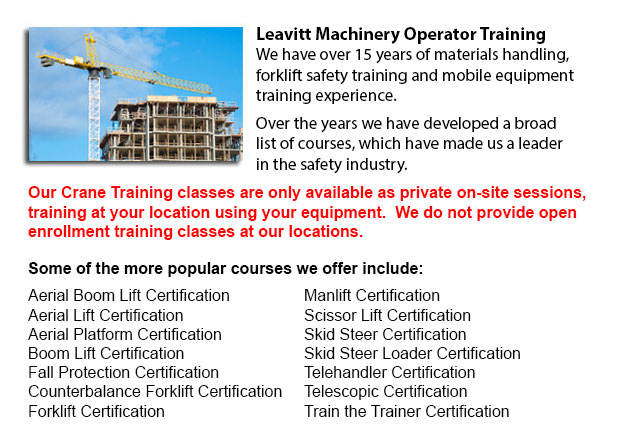
Kitchener Overhead Crane Operator Training - Our overhead crane operator training course is designed to teach employees the basics of overhead crane/sling operation and pre-shift checks. Courses are taught by our expert trainers and consultants. Well-trained staff are more productive and efficient, that saves on costs associated with property damage, merchandise damage, and accidents because of the utilization of improper operating measures. Our overhead crane certification is customized for employees who have literacy barriers, reducing certification time by 50 per cent.
Overhead cranes are suitable for particular repetitive hoisting activities. This kind of crane has wide ranging capacities. They could be utilized for specialized lifting tasks like removing or installing major plant equipment.
Worker and operators need to employ safe rigging practices in order to safely operate an overhead crane. This would need both practice and knowledge as the load needs to be correctly rigged to guarantee its stability when hoisted. Before beginning a lifting job, it should be determined that the crane is right for the job, with right lift, capacity and travel. The crane must be subjected to a thorough visual and physical check before utilization. The capacity of all equipment, including the hardware, rope and slings, should never go over load weight capacities.
The rigger must know the correct sling for every lift and check slings and other rigging hardware prior to using. Clear signals need to be used in communications with the crane operator. A signaler should be chosen for the role and signals should be agreed upon. The crane operator must follow instructions from the designated individual only. If a wired or remote controller is being utilized, the operator must be trained in all its functions.
Prior to any lifting begins, the path of the load must be cleared of all obstacles and a warning sign must be issued to be able to ensure the safety of the workers. Pedestrian are not under any circumstance allowed to walk under the lift loads. The crane hoist has to be centered over the load before hoisting to prevent swinging. The safety catch should be closed immediately after sliding the sling fully onto the hoisting hook. Sling legs which are not utilized should be secured so they do not drag. Never leave loose materials on a load being lifted. Watch that hands and fingers are clear when slack is taken out of a sling. Before the lift is made, step clear of the danger zone.
-
Kitchener Forklift Training Schools
Kitchener Forklift Training Schools - The Advantages Of Taking One Of Our Forklift Training Schools Are you searching for work as a driver of a forklift? Our regulatory-compliant mobile equipment operator training offers instruction in types of fo... More -
Kitchener Crane Training School
Kitchener Crane Training School - The crane training school offers industry-relevant programs. Courses provide trainees with learning outcomes which match present industry demands. Our small class sizes combine hands-on experience and theory. Our qua... More -
Kitchener Skid Steer Ticket
Kitchener Skid Steer Ticket - The lift arms on the skid-steer loader are located at the side of the driver along with pivots behind the driver's shoulders. These features makes the skid-steer loader different as opposed to the conventional front load... More -
Kitchener Manlift Operator Certification
Kitchener Manlift Operator Certification - Our scissor platform and aerial lift training and certification empowers participants with a knowledge and general understanding of the efficient and safe use of "Power Operated Mobile Work Platforms," under... More -
Kitchener Crane Safety Training
Kitchener Crane Safety Training - Companies and crane operators have to be aware of the problems related to crane safety. Legislation provides rules for the safe operation, inspection and maintenance of lifting machines all around North America. Cran... More -
Kitchener Forklift Training Programs
Kitchener Forklift Training Programs - Are you searching for work as a forklift driver? Our regulatory-compliant mobile equipment operator training offers instruction in kinds of forklifts, pre-shift check, fuel kinds and dealing with fuels, and safe... More -
Telehandler Training in Kitchener
Telescopic handlers often known as telehandlers for short, are an extremely popular piece of heavy construction machinery. They are commonly used in the construction and agricultural industries. These equipments have extreme reaching ability and can... More -
Kitchener Loader Ticket
Kitchener Loader Ticket - Gehl articulated loaders have been made to suit just about any condition. They provide great traction and optimal maneuverability thanks to a heavy-duty oscillating joint that offers 45-degree rotating angles right and left,... More

Forklift Certification Kitchener
TOLL FREE: 1-888-254-6157
Kitchener, Ontario
forkliftcertificationkitchener.com
Email Us
About Us


